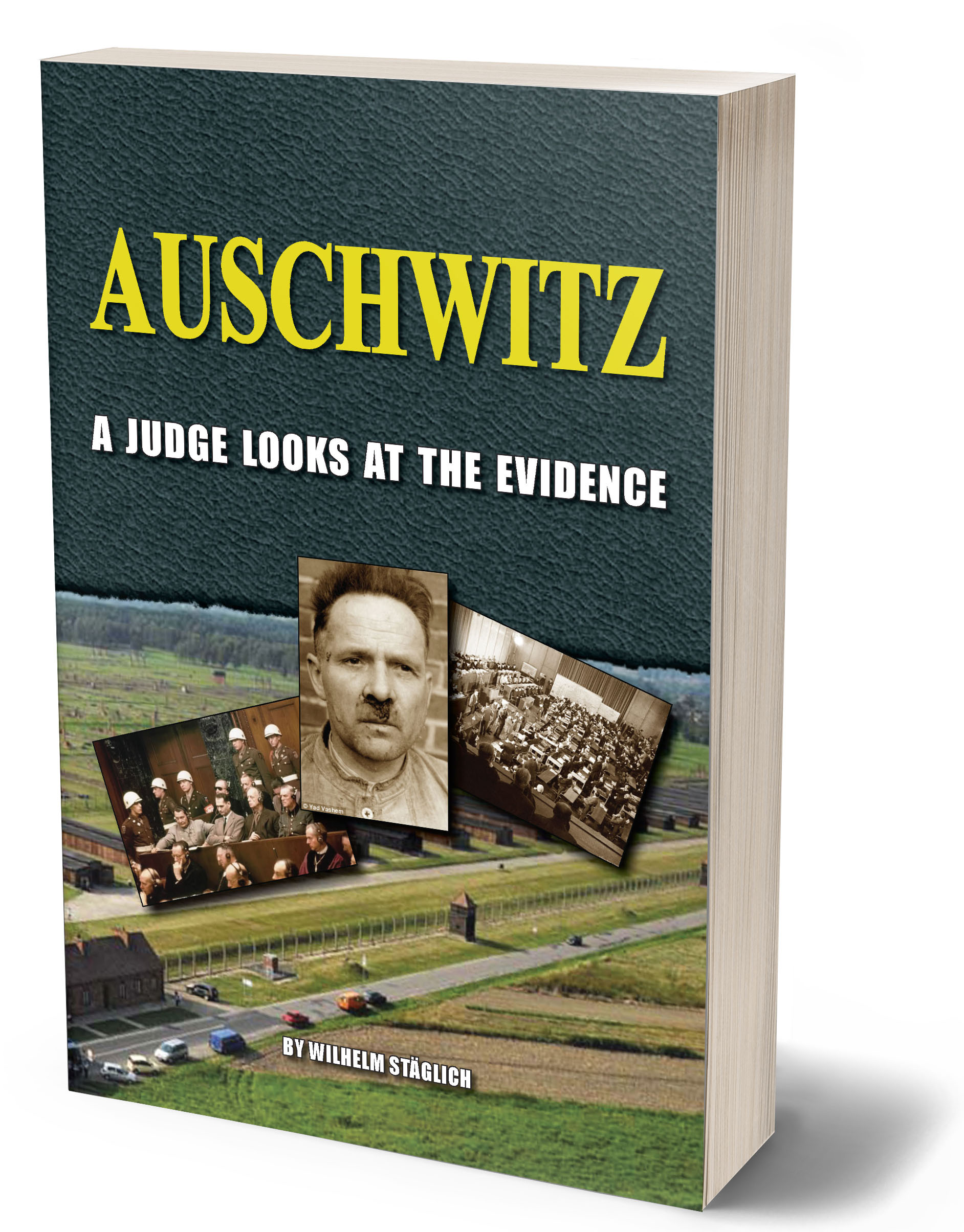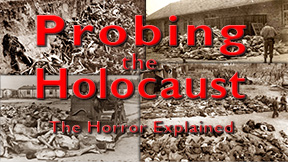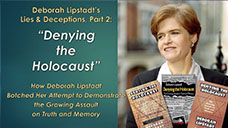Toward the end of the Second World War, Wilhelm Stäglich, at that time an officer in the German air force, was stationed in the industrial area of Upper Silesia. He was to help in the defense against Allied bombers who sought to destroy the last intact German industrial area. Stäglich was stationed near the Auschwitz concentration camp, as many other German soldiers were at that time as well.
In the course of the increasing media propaganda about Auschwitz in the 1960s, caused primarily by the great Frankfurt Auschwitz trial from 1963 to 1967, Stäglich felt obliged to relate his experiences during the war at Auschwitz. He therefore wrote a letter, initially not meant for publication, to the German monthly magazine Nation Europa. In it he explained that, during his military service near the camp, he had experienced nothing indicating that the attested-to mass gassing or other atrocities had indeed happened. Only in 1973, after Thies Christophersen had published his (in)famous brochure The Auschwitz Lie, did he allow his letter to be published, because the experiences Christophersen describes in his brochure confirmed what Stäglich had witnessed. Stäglich’s letter appeared in the October 1973 issue of Nation Europa. In this brief article Stäglich did not yet challenge the possibility that such gassings had happened. He merely stated that he had not observed any inhumane treatment of inmates and that to him the inmates seemed neither frightened nor intimidated. He did not accuse anyone, did not insult anyone and did not suspect anyone of any wrongdoing.[1] But his heretical doubt was already bad enough for the establishment.
As a consequence of this letter to the editor, Stäglich was subjected to disciplinary procedures aiming at removing him from his position as a judge at the Hamburg Finance Court. During this procedure Dr. Stäglich decided to retire early for reasons of health. At the end of these disciplinary procedures, his pension was cut.
Inspired by this witch hunt against him and with lots of spare time at his disposal, Wilhelm Stäglich dedicated the full creativity of his best years to the task of investigating the Auschwitz subject to the best of what he was able to do at that time and with the full exactitude of his profession. Working through the pertinent literature and all accessible court files led him to the discovery of a veritable bundle of whopping lies on the part of politically and financially interested parties. In addition to this he revealed serious deficiencies in the way the courts conducted the relevant criminal cases and handled the evidence. Yet Stäglich did not find the slightest indication that he had erred in his letter to the editor. He therefore saw no reason to correct himself, but decided to the contrary to publish the results of his thoroughgoing inquiry as a book. He trusted in the Basic Law, Germany’s notional constitution, which states in the first paragraph of its Article 5:
Everyone has the right to freely express and disseminate his opinion in word, writing and image …
He was determined to exercise the right set forth in the third paragraph of the same Article, which states:
Arts, science, research and teaching are free.
The result of Stäglich’s research was published in German in 1979 by the southwest German Grabert publishing company. The first English translation, published by the California-based Institute for Historical Review, appeared in 1986 with the title The Auschwitz Myth. A second edition appeared in 1990 with the current title. It has been out of print for many years now, although there seems to be a demand for it. One online book seller even had the audacity to offer an allegedly new copy of it for almost $7,000 on Amazon!
While editing the present edition in close comparison with the German original, I discovered a number of mistranslations as well as missing phrases and sentences, even entire omitted paragraphs. These and other mistakes have been corrected for this edition. A very few additional remarks have also been added to a few footnotes where I considered it pertinent. Other than that, Stäglich’s text has been reproduced faithfully. I was unable to reproduce the original illustrations in the appendix, though, because the original photos have been lost.
Also, since this book caused a barrage of persecutorial measures against its author and publisher in the years following its publication – so much for freedom of speech – an essay describing these scandalous events has been added to the Appendix.
This new edition appears 36 years after the publication of the first German edition. Something would be very suspicious indeed, had the research on Auschwitz not made great progress. Hence it cannot be expected that the state of knowledge accessible to Stäglich in the 1970s would still be up to date and correct in all aspects. While reading this book, the reader should therefore always keep in mind that, in the present day, this is a historical document.
When reprinting such works, any publisher always has to ask whether this inadvertently expresses continuing credence to old errors and deficiencies. It would certainly be preferable to publish a completely new book on the “Auschwitz Myth” based on the most recent research results. But who would take on such an unrewarding task, which would cost many years of hard work but at the end of it would probably merely generate disparagement, contempt and persecution?
Alternatively one could publish a “critically commented” edition. But such an enterprise would also be quite laborious considering both the volume of the present work with its huge number of references and footnotes and the progress research has made over the past three and a half decades.
We therefore decided instead to highly recommend to readers the more recent revisionist literature, based upon which they can get an understanding of the current state of knowledge. Most important in this context is the prestigious series Holocaust Handbooks, which currently consists of almost 30 monographs: see www.HolocaustHandbooks.com
Among these books, one deserves to be especially emphasized: the Lectures on the Holocaust. It gives a comprehensive overview of the current state of research on the Holocaust. The book is continually edited and frequently revised and updated by a group of revisionist authors.
Among the Holocaust Handbooks are a number of monographs with special focus on various aspects of the Auschwitz camp, which give a fairly up-to-date overview on research about that camp and which are indispensable for all those who want to be thoroughly informed about Auschwitz:
- The Rudolf Report (2nd ed. 2011)
- Auschwitz: Plain Facts (2005/2010)
- Special Treatment in Auschwitz (2004)
- Auschwitz: The First Gassing (2nd ed. 2011)
- Auschwitz: Crematorium I (2005/2010)
- Auschwitz: Open Air Incineration (2005/2010)
- The Bunkers of Auschwitz (2004)
- Auschwitz: The Case for Sanity (2010)
More details about these and other books about the Holocaust can be found at the end of this book.
Since the publication of the first German edition of the present book in early 1979, large parts of the documentation of the Auschwitz Trial conducted in 1964/65 in Frankfurt upon Main, Germany, have been published.[2] Wilhelm Stäglich deals at great length with this trial in the present book, although most of these documents were not at his disposal back then. Today these documents enable the interested reader to gain a deeper insight into the history and background of this German trial, which has been pivotal for the consolidation of the Auschwitz Myth.
In addition to this, I myself have analyzed the first seven binders of the pre-trial investigation records, which encompass all in all 77 binders. The papers I have published about this give the reader a good overview as to how this mammoth trial was initiated.[3]
Although I stated earlier that I’m not going to revise Stäglich’s book, there is one issue I’d like to discuss here briefly, and that is the number, layout, history and equipment of the crematoria in the Auschwitz-Birkenau camp. Stäglich spends a lot of time in the present book trying to figure out how many crematoria there were, how big they were, when they were built and went into operation, how the various rooms in it were arranged, and what equipment there was, in particular the types and quantity of cremation furnaces and other auxiliary devices. The sources he then had at his disposal made many contradictory claims in this regard, which made him suspect that Birkenau may have had only one crematorium.
In the mid and late 1980s, the Polish Auschwitz State Museum started giving certain scholars access to its archive, which contains many documents from the files of the former Central Construction Office at Auschwitz. One of these scholars was the French pharmacist-turned-historian JeanClaude Pressac, who in 1989 published a large-format book containing hundreds of reproductions of many of these documents, including building blueprints, cost estimates, invoices, and also wartime photos of the Auschwitz and Birkenau camps with their many buildings, some of them at various stages of construction. The book can be accessed online.[4] From it, the reader can get a fairly good impression about the crematoria built at the Auschwitz main camp and at Birkenau, among other things.
This was only the start, though, because when the Soviet Union collapsed in 1991, it was revealed that at war’s end the almost complete files of the former Central Construction Office at Auschwitz had been looted by the Soviets and brought to a Moscow archive. In the 1990s these documents were made accessible to anyone, revisionists included. Although Pressac sifted through some of these documents, some of which he used in his second book,[5] a much more thorough analysis of this archival resource was performed by Italian scholar Carlo Mattogno. He subsequently published a number of books on various aspects of the Auschwitz camp, whose documentary mainstay consists of material from this Moscow archive. Most of the Holocaust Handbooks listed above were therefore authored by Carlo Mattogno (some with co-authors).
When analyzing these Moscow documents, it turned out that they had been thoroughly scrutinized several times by the Soviets, as is indicated by various archival imprints left on many of the documents. Yet still, the Soviets never made any use of them and did not even reveal the documents’ existence and whereabouts. The reason for this is clear: these files not only contain no proof for what the Soviets were looking for – evidence for the “machinery of mass murder” – they actually contain plenty of material that refutes such claims.[6]
But back to the crematoria. Based upon the plentiful documentation available today, it can be said with certainty that there were indeed four crematoria at Birkenau. And it can also be said with certainty that these crematoria were similar in design and capacity to any other civilian crematorium of the time. They were not of any special design facilitating any kind of mass murder.
The two larger ones of these crematoria (nos. II & III in today’s notation, but nos. I & II in the Auschwitz construction files), the first of which was planned starting in late 1941, were mirror images of each other, had two semi-underground morgues measuring 7 m × 30 m and 8 m × 50 m, respectively, and a furnace hall on the ground floor, which housed five triple-muffle cremation furnaces (hence 3×5=15 muffles or retorts, i.e., cremation chambers). Their exhaust gases exited through a single large chimney with three flues. The corpses were transported from the morgues in the basement to the furnace hall using a small freight elevator which could carry only a few corpses at a time.
The two smaller crematoria (IV & V in today’s notation), likewise mirror images of each other, were planned starting in the summer of 1942 and were cheaper in design, as they were hastily designed, i.a. as a reaction to the catastrophic typhus epidemic which broke out in July 1942 and raged in Birkenau with varying intensity for well over a year. At one end the buildings had a furnace hall equipped with four double-muffle furnaces which were grouped together into one large 8-muffle unit to reduce heat losses. Their exhaust gases escaped through two separate, smaller chimneys. All rooms in these buildings were above ground.
In an annex at the other end of these buildings were located three rooms whose function is not mentioned by the extant building plans, but from existing invoices and work sheets it can be gleaned that one of the rooms was a (real) inmate shower room, and another was at least temporarily planned to serve as a “gas chamber,” a term which, when showing up during the war in German technical literature or construction documents, always referred to Zyklon B delousing or disinfestation chambers. But since the documentary evidence indicates that the ventilation system initially planned for this part of the building was never installed, it may be assumed that even the project to use that room for disinfestation purposes was abandoned. The reason for this was probably the fact that a different, larger, more suitably designed building was at that time also reaching completion right next to these crematoria – the so-called “Zentralsauna,” a large hygienic complex with inmate showers and hot air disinfestation chambers.
In the new Appendix IV I added a few ground plans of the Birkenau crematoria as well as photographs taken by SS-Unterscharführer Dietrich Kamann, a member of the Central Contruction Office who was documenting the construction progress of these and other buildings at that time. This way the reader can get a good impression of these facilities.
With all this in mind, readers can decide for themselves which description of the crematoria by which witness discussed by Stäglich comes closer to the truth.[7] Although Stäglich’s skepticism about the actual existence of these buildings is out of place today, we must always remember that our knowledge today is so much larger and deeper than what Stäglich could know back in the late 1970s when wrote his book.
Germar Rudolf, January 2015
| [1] | See the English translation of this paper in Appendix II of the present book. |
| [2] | Fritz Bauer Institut, Staatliches Museum Auschwitz (eds.), Der Auschwitz-Prozeß: Tonbandmitschnitte, Protokolle, Dokumente, Direct Publishing GmbH, Berlin 2004; online: www.auschwitz-prozess.de. |
| [3] | Although Stäglich notes correctly that ordinary mortals cannot get access to these trial records (see his note 66 to Chapter Four, p. 320, as well as Appendix III), a lot can be achieved with money and good connections … see the eight installments of the series “From the Records of the Frankfurt Auschwitz Trial,” in various editions of the periodical The Revisionist, 1(1) (2003), pp. 115-118; 1(2) (2003), pp. 235-238; 1(3) (2003), pp. 352-358; 1(4) (2003), pp. 468-472; 2(2) (2004), pp. 219-223; 2(3) (2004), pp. 327-330; 3(1) (2005), pp. 92-97; 3(2) (2005), pp. 189-196; online: www.vho.org/tr and www.codoh.com/library/categories/1178. |
| [4] | Jean-Claude Pressac, Auschwitz: Technique and Operation of the Gas Chambers, Beate Klarsfeld Foundation, New York 1989; www.holocaust-history.org/auschwitz/pressac/technique-and-operation/ |
| [5] | Jean-Claude Pressac, Les crématoires d’Auschwitz: La machinerie du meurtre de masse, CNRS, Paris 1993. As copiously documented as Pressac’s books are, they both are seriously flawed when it comes to the author’s attempt to prove that Auschwitz was an extermination camp. See the next footnote for more on this. |
| [6] | On this see primarily C. Mattogno, Auschwitz: The Case for Sanity. A Historical and Technical Study of Jean-Claude Pressac’s “Criminal Traces” and Robert Jan van Pelt’s “Convergence of Evidence,” The Barnes Review, Washington, DC, 2010. As the subtitle suggests, this book also tackles Jean-Claude Pressac’s ill-conceived notions about the alleged homicidal function of the Birkenau crematoria. |
| [7] | As could be expected, since he had to know it, the commandant of the Auschwitz camp, Rudolf Höss, got closest to the truth regarding the history, layout and equipment of the crematories in his memoirs Die Endlösung der Judenfrage im KL Auschwitz (see p. 257 of this study), although his claims about the gas chamber and cremation capacities are way off the mark. |







